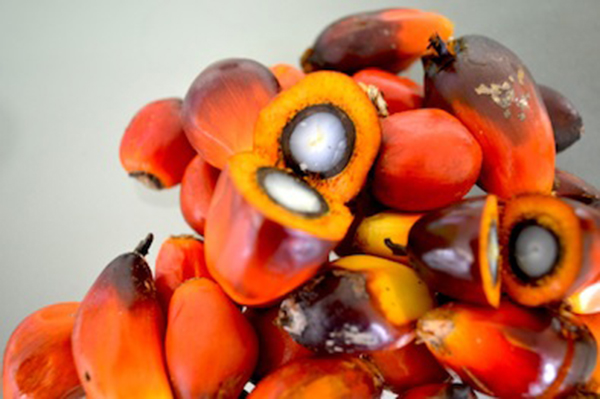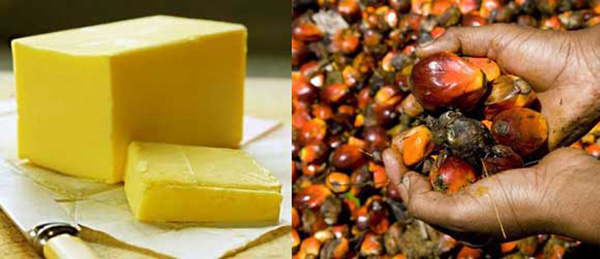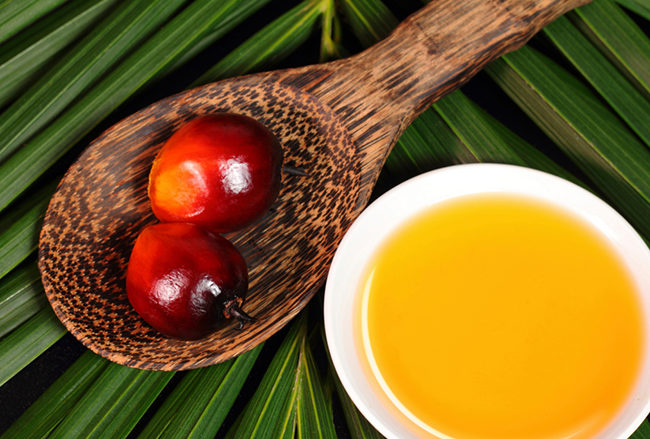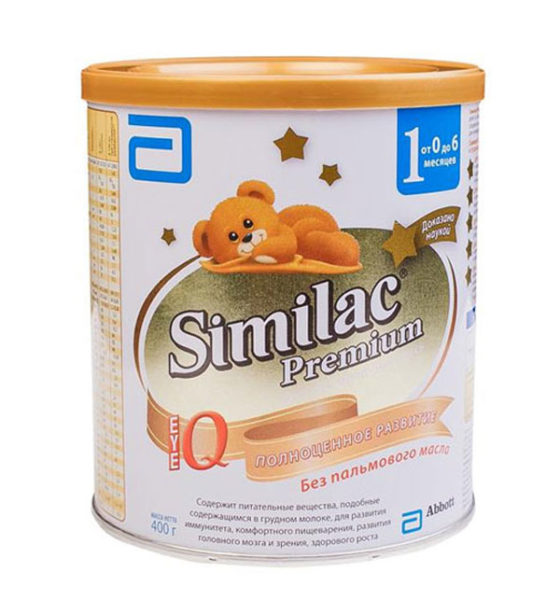Health is the most valuable thing that every person has. It is about his maintenance and preservation that should be taken from an early age. In this matter, the main role is played by the diet of a person, on the correctness of which the state of health, the appearance of a person and his mood directly depends. The correct diet is a very complex system that should include all the most necessary products, vitamins and minerals.
Content
However, in the modern world, products are increasingly found, about whose usefulness and harmlessness there are constantly disputes. The most urgent issue today is the following: whether there is palm oil in food and what is dangerous to palm oil for human health. In print publications, on television, hot disputes of the opposite nature are underway to identify the true position of palm oil on the world market and its effect on the human body.
In this article, we will consider the main characteristics of palm oil, and also reveal the benefits and harm of palm oil for human health. Note the danger of a product for children and give a list of mixtures without palm oil in the composition.
What is palm oil, its composition and characteristic
Among the whole variety of food products, oils, which in their composition contain a large number of substances that are in their composition, play an important role. These oils are a kind of lubricant for the joints, help the full operation of internal organs. Today, there are a large number of different oils, among which palm oil is considered the most contradictory.
Palm oil since ancient times has been used all over the world. In countries such as Malaysia, Indonesia and the African countries, a huge number of population is engaged in the production of this oil, which provides them with earnings and a tolerable life. These countries are the main suppliers of palm oil. In recent years, its development has increased significantly, because it is the cheapest fat all over the world and is used in many areas of human life.
According to the World Wildlife Fund, today almost 50% of all packaged products contain palm oil. This makes you think about its harm to human health. In Russia, palm oil appeared relatively recently. Of course, it used to be used to prepare various desserts with a long expiration date. However, today it began to use it massively in the production of various products.

The composition of palm oil
Today, debate does not subside about which palm oil is harming for human health. In this matter, there are two sides that adhere to absolutely opposite points of view. Some argue that palm oil in nutrition can cause huge human health problems. Others suggest at the beginning to find out specifically the composition and area of \u200b\u200bthe influence of palm oil on a person, and only then understand whether it is harmful or, conversely, useful. Let us consider in more detail what palm oil is made of in order to further understand its effect on our body.
For the production of palm oils, oil types of palm trees are used, which grow for the most part on the territory of North Africa. Indonesia and Malaysia. To prepare this disputed product, the pulp of ripe fruits of such palm trees is used. These fruits are initially boiled, and after that the oil is squeezed. In its natural form, palm oil is a liquid butter, which has a bright orange yellow and pleasant smell. The taste of natural palm oil is slightly sweet.
In its composition, palm oil contains a large amount of palmitic acid. However, this is not the only saturated fatty acid from which this oil consists. It also contains stearic acid, aleic, arahin, linoleic and other saturated and unsaturated fatty acids. In addition to these components, palm oil contains a large number of vitamins E, D, K, A, lecithin, phytosterol, Coenzyme Q10, which is responsible for the youth of the skin. It is also worth noting the high content of phosphorus and magnesium in this product.

Basic characteristics of palm oil
- Palm oil in food products allows you to extend their expiration date.
- It is the cheapest and affordable vegetable fat oil in the world market, which is why it is so widely used.
- Palm oil can be of several types, the separation of which depends on what is used for its production.
- In its natural form, palm oil has a liquid consistency, when heated it becomes more flowing, and with slightly cooling it turns into a solid substance that resembles margarine.
- Due to its rich composition, palm oil is the most close vegetable oil to animal fats. That is why it is often used as a replacement for a more expensive creamy oil.
- Palm oil has good resistance to oxidation processes, so it can be stored for a long time and not deteriorated.
- The oil has a great food value and the fats included in its composition are well absorbed by a person and have a beneficial effect on his body.
- One type of palm oil is red oil with an antibacterial effect, so that next to it is simply impossible to develop pathogenic bacteria.

Palm oil production technology
In Russia, palm oil is not produced, it is brought from tropical countries that are leaders in this area - Malaysia and Indonesia. In these territories, they have been engaged in the production of palm oil for a very long time, most of the population is so making a living. Palm oil is produced from an oil palm, whose homeland is considered to be Guinea. This country is on the African continent, so there is nothing surprising that this culture has spread further. To date, Malaysia is considered the leader in palm oil, where its sale is most of the country's GDP.
Palm oil is mined by a special method - cold pressing. For this, a variety of wood are used. The most valuable oil in composition is made of pulp of fruits and seeds of a little palm. Initially, parts of the fruits are cooked, and after that, oil is squeezed out with the help of the press.

Types of palm oil
Palm oil is completely different, its benefits and harm directly depend on the method of processing raw materials and natural consistency. From existing and used throughout the world, red palm oil can be distinguished, refined and deodorized palm oil, as well as a technical one. Consider the features of each type of this product.
Red palm oil
This type of palm oil is the most natural. It is a liquid, a flimsy consistency of a bright red-orange shade with a sweet taste and a pleasant nut aroma. This palm oil is mined using gentle technologies, which allows you to maintain the maximum amount of its beneficial properties. It is in red palm oil that a large amount of vitamins A, E, D are contained, therefore its use can be associated with free radicals that cause oncology. However, this type of oil is not so harmless. Its excessive use can cause obesity. In addition, red palm oil is poorly digested by the human body, so some part of it settles inside in the form of toxins.

Refined and deodorized palm oil
If we talk about palm oil, do not forget about food oil, which is differently called refined and deodorized. It is this oil that is used in food products. It is an almost colorless liquid that is completely devoid of smell and taste. After processing, this oil loses almost all the beneficial properties, but acquires a longer shelf life. It is for this quality that this type of palm oil is valued by food manufacturers - it allows you to reduce the cost of the product and extend its expiration date. Excessive use of this oil can have a negative effect on the human body, in particular on the cardiovascular system.
This type of oil is often subjected to hydrogenation. This process is a saturation of oil mass by carbon for the transfer of oil from a liquid state to a solid one. Such palm oil is used for the preparation of margarine, spread. Hydrogenized palm oil after processing completely loses all its beneficial qualities and, when human consumption, can have a harmful effect on his body. In Russia, there is a special GOST according to which food palm oil should be used.

Technical palm oil
There is another type of palm oil - technical. This oil, in which the acid-base composition was completely changed, which led not only to the loss of all useful components, but also made this oil dangerous to human health. Technical palm oil is the cheapest and is used in industry and cosmetology for the production of washing powders, cosmetics, soap, candles, and medications. Its use by a person is unacceptable, as this can lead to the appearance of plaques and oncological diseases. In this case, it is not necessary to talk about the benefits of palm oil.
Palm oil use area
In recent years, palm oil has become the most popular vegetable fat, thanks to its different properties. This is also due to the fact that in comparison with other types of oil, the production of palm oil is much cheaper, which, in turn, reduces the cost of products.
Using palm oil in the food industry
Palm oil received the widespread widespread in the food industry. This became possible due to the property of this oil to increase the expiration date of the products. For the first time, palm oil began to be used to prepare some products in 1985 after the research of American scientists who have proved the effectiveness of oil use in this field. Until that moment, palm oil was used in history only for technical purposes.
- Most often, palm oil is used for products with a long shelf life.
- You can find palm oil in dairy products: various cheeses and melted cheese, butter, margarine, spread, confectionery fat, sour cream, mayonnaise, yogurt, cottage cheese, ice cream, condensed milk.
- Palm oil is used for deep fruit in the preparation of chips, squid rings, free potatoes, chicken wings in restaurants and cafes.
- The largest use of this oil in the manufacture of confectionery with a long shelf life. Oil is used for cream, biscuits, waffles, sweets, chocolate pastes and glaze, cookies and cupcakes.
- Palm oil in baby food is often used, which is a controversial subject of discussion among young mothers. Palmitic acid contained in palm oil is an important component of the mixture for feeding babies. This allows you to bring the mixtures for feeding to breast milk. On sale you can also find mixtures without palm oil, however, which of them has not yet been proven.
- In order to determine palm oil in food, it is worthwhile to read the composition carefully. If it contains vegetable oil without the exact name and the cost of this product is much lower than similar, then it is likely that it contains palm oil.

Palm oil in cosmetology
Palm oil in cosmetology is widely used. It is added to various creams due to its consistency and included in vitamins and minerals. Palm oil in cosmetics is in combination with other drugs that enhance the general effect. Creams with palm oil contribute to the healing of small wounds and cracks on the skin, as well as due to the presence of coenzyme Q10 in the composition of oil, they moisturize and nourish the skin, prolonging its youth and elasticity. That is why palm oil is often used to produce cream for fading skin after 45-50 years.

Palm oil in the chemical industry
Palm oil is also used in the chemical industry. For these purposes, technical palm oil is suitable. This component is often found in soap, both liquid and solid. Palm oil is added to a variety of washing powders and rinses. This type of oil is used in the manufacture of candles.
Palm oil in medicine
It is not surprising, but palm oil is also used in the production of medications. This substance is widely used in the manufacture of drugs for the treatment of vision problems. This includes drugs for the treatment of glaucoma, conjunctivitis, chicken of blindness. With the use of palm oil, pharmaceutical companies produce various drugs aimed at treating a variety of diseases of the cardiovascular system, gastrointestinal tract.
As can be seen from the above areas of use, palm oil can have both positive and negative aspects, which must be taken into account when deciding the issue of the benefits and dangers of this product.
The benefits and harm of palm oil for humans
In order to get a specific opinion about the effect of palm oil on the human body, it is important to consider all its positive and negative sides.
The benefits of palm oil:
- First of all, palm oil, especially natural red. It contains a large amount of carotene. Thanks to this, this substance is considered one of the strongest antioxidants that can fight free radicals and prevent the appearance of cancer formations. This component in palm oil is able to make the skin more smooth and moisturized.
- Palm oil has a positive effect on the state of the human heart and its vessels. That is why it is prescribed for preventive purposes to prevent heart attacks, strokes, coronary disease, hypertension.
- In its composition, palm oil contains a large amount of vitamin A, so it is recommended to be used for various eyes of the eyes. It is part of the drugs for the treatment of cataracts, chicken of blindness, glaucomas. It helps protect the eye lens, retina and cornea, normalizes intraocular pressure and blood circulation.
- The use of palm oil has a beneficial effect on the work of the gastrointestinal tract. It can quickly heal the wounds on the mucous membrane of the stomach, remove inflammation. No matter how strange it sounds, palm oil prevents the accumulation of fats in the liver. Doctors recommend using palm oil for a stomach and duodenal ulcer, with cholecystitis, biliary disease, colitis and gastritis.
- Due to the presence of vitamin E, palm oil protects the human body from the effects of harmful toxins, strengthens immunity. In this case, palm oil nourishes the skin, makes them more elastic and elastic. Protects the surface of the skin from bacteria and viruses.
- Palm oil is very useful for the female body. Due to the large number of vitamins A, E palm oil helps normalize the hormonal balance and promotes its adjustment. Palm oil also has an anti -inflammatory effect in various diseases of the uterus and ovaries. When using this product during pregnancy, you contribute to the full development of the fetus.
- Palm oil is useful for children. It is involved in the formation and strengthening of bones, teeth and joints. Promotes the formation of organs of vision, brain and nervous tissue.

Than palm oil is harmful:
- Palm oil in its composition contains a large amount of saturated fat. That is why excessive use of this oil can contribute to the occurrence of heart and blood vessels. The blood cholesterol level may increase, which causes blood vessels thrombosis, atherosclerosis. Palm oil must be consumed in limited quantities. Although this rule exists for the usual butter.
- Excess of palm oil contributes to a violation of the digestive system.
- Palm oil is the strongest carcinogen, because of this, many countries have a ban on the use of palm oil for cooking food.
- Palm oil contains a small amount of linoleic acid, which makes this oil less valuable.
- Our body does not digest palm oil poorly due to the melting point, which is 40 degrees. This leads to the fact that the decay products of this oil settle in the body in the form of toxins.
- Fatty acids that are contained in palm oil gradually glue blood cells, which can lead to oncological diseases.
Than palm oil for newborns is harmful
Many young mothers are worried about whether the content of palm oil in baby food and mixtures is harmful. It is worth noting that palmitic acid is the main component of such mixtures, since manufacturers strive to first of all bring baby food in composition to breast milk. It is quite difficult to do this, since there are problems with the choice of specific oil and fats. Cow milk is very different from the breast, so manufacturers turned their attention to vegetable oils, which are much more similar in composition to maternal.
The content of palm oil in children's mixtures is useful in a high content of vitamins A, E, which contribute to the formation and strengthening of bones, teeth, brain and nervous tissue. Saturated fatty acids, of which palm oil consists, are necessary for the child as a source of energy and for the construction of hormones and cell membranes.
But palm oil, which is included in children's mixtures, can bring the child’s health not only benefits, but also harm. This is due to the fact that palmitic acid contributes to poor absorption of calcium by a child's body. Also often in children who are fed with mixtures with palm oil, constipation are observed in the composition.
Although there are some negative aspects of the use of palm oil in children's mixtures, the children who feed on them grow and develop without deviations. The additive in the form of palmitic acid in children's products is allowed by all instances.

Using children's mixtures without palm oil
Manufacturers are constantly working on improving the composition of children's mixtures and approaching it to breast milk. However, still today, the breast milk of the mother, which contains all the necessary elements, is the perfect nutrition for newborns. If you want to use mixtures with palm oil, manufacturers produce mixtures without this component or replace it with another substance.
- Palm olein is added to some mixtures, which contains slightly less fatty acids.
- Today, manufacturers are trying to add as little palm oil as possible to children's mixtures.
- There are mixtures in which there is no palm oil at all. This is Nanny and Similak. However, these mixtures are less similar in composition to breast milk.
- The last achievement of scientists in terms of developing an improved children's mixture was the creation of a structured or beta-palmitate from palm oil. Such mixtures are better absorbed and do not cause constipation. How to check the palm oil in the composition-just look at the composition: here should be indicated a beta-pales or structured palm oil. Such mixtures include Nutrilon, Heinz, Cabrities.

There is no ideal mixture for feeding newborn, it is almost impossible to make it. Therefore, if possible, give your child breast milk. And regarding the harm and benefits of palm oil for human health, everyone decides to use it independently or not. In any case, if the use of products with these oil is limited, then there will be no harm.









Comments
a couple of years ago, there was no side of metrogils from the same problem, there were no side effects ...
I’m not a fan of peeling at all, it saves from acne of metrogil, it also smoothes it ...
Great article! ...
I take the second course of the Capsules Climafite 911. The tides went very quickly. It became calmer, irritability went away and I sleep well ...
i also noticed - it is worth nervous, everything immediately affects the face. Therefore, I try to avoid conflicts and unpleasant people. Of the creams, I like Miaflow from wrinkles - smoothes not only small wrinkles ...